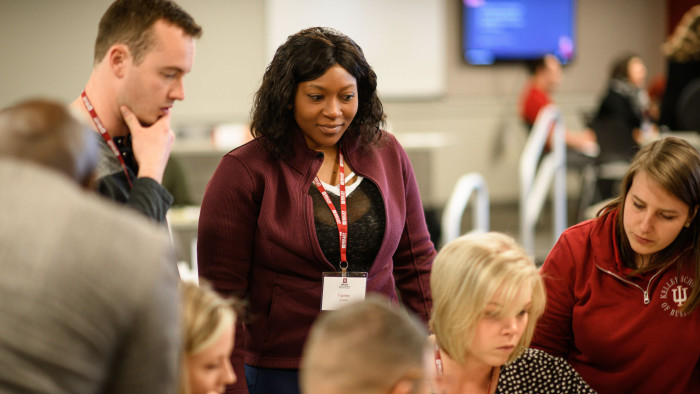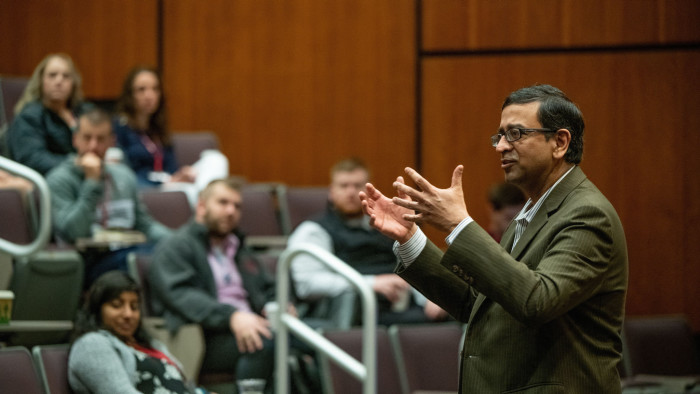Why an online MBA doesn’t mean forgoing real-life networks

Roula Khalaf, Editor of the FT, selects her favourite stories in this weekly newsletter.
For many managers keen to study for an MBA, the prospect of face-to-face networking makes on-campus courses the preferred option. But the travel clampdown caused by coronavirus, as well as the closure of some campuses, may force them to sample the alternative of online learning.
If they do, they will be reluctantly following in the footsteps of the many students — and teachers — who long ago concluded that online study is the best fit both for busy lifestyles and for consciences troubled by the environmental consequences of international flights.
One high-level convert to online learning is Alison Fragale, a professor at the University of North Carolina’s Kenan-Flagler Business School who teaches classes in negotiation from her home in Chicago. On a typical morning there she might be sharing her insights with UNC-enrolled students across time zones ranging from dawn in California to evening in Singapore.
Though she was initially doubtful about this approach to business education, it is, she says, one of the “most rewarding” things she has done. “It forces you to take a critical look at your teaching, and recognise how complacent you can become in the face-to-face classroom,” she explains.
For students drawn to an MBA in part by the opportunity to build life-long networks through classroom sessions, group work and intense socialising, the appeal of doing the course remotely may seem limited. But a mixture of technological advances, changing cultural habits and carefully crafted programmes are helping to make online MBAs more attractive.

Improvements in digital communications have played a big part. Prof Ramesh Venkataraman, chair of direct MBA and MS programmes at Indiana University’s Kelley School of Business, says: “Seven years ago it was hard to teach online because of poor bandwidth. The technology meant you were not able to simulate what you can do in the classroom.”
He recalls the necessity of “asynchronous” teaching, where course participants independently posted written comments to discussion forums and there was no interactivity. “Now it’s very natural,” he says. “I would argue there are things we can do even better than in a face-to-face classroom.”
Like his peers elsewhere, Prof Venkataraman uses virtual “breakout rooms”, where students hold small group discussions in real time and make notes in Google documents that can be tracked systematically and shared with others. “You can’t do that very well in a real class, where it’s all talking and you are not recording anything,” he says.
He also argues that the use of written online commentary can “even out the playing field” for shy students: unlike a live classroom discussion, it allows them time to reflect and contribute, rather than being drowned out by noisier participants.
Meanwhile society has kept pace with technology. Prof Fragale argues that the current generation of students, as well as professors of all ages, are increasingly comfortable with digital interaction. Many routinely use collaboration tools such as Slack and Zoom at work, as well as Facebook and WhatsApp in their social lives.
Martin Boehm, dean of IE Business School in Madrid (which is the FT’s partner in Headspring, an executive development venture), says that online learning can sometimes be “more personal” than the offline variety. “I remember a participant who said to his classmates ‘I let you all into my family, my house, you see my wife and my kids’,” he says.
He contrasts some of his face-to-face full-time MBA students, who are “self-funded, soul searching, and often don’t know what they want to do”, with the greater determination of their online counterparts, who are typically working while studying. This real-world exposure can also enrich class discussions. “We encourage them to bring challenges from their work into the class,” Prof Boehm says.
Equally, the pressures of balancing study with work and family life can be intense. But Prof Boehm says that fellow students often step in, share their own experiences and encourage anyone who is struggling to stick with the course. Teaching staff also provide support, with a ratio at IE of one faculty member to 35 students online — almost twice the level of the full-time classroom-based MBA.

Student engagement is also strengthened by the fact that many online providers still insist on some “blended” learning — that is, learning that requires the student’s physical presence. At Kenan-Flagler, that takes place during “summit” gatherings on campus or in a city overseas. And at IE, students are expected to spend two to three weeks on campus, including at the start of their course.
“They meet right at the beginning,” says Prof Boehm. “They make good use of their time — they work, study, party really hard. They don’t sleep.” That provides personal contacts which can then be nurtured remotely, in chat rooms, class discussions and group work.
Prof Venkataraman acknowledges that there are still limitations to online learning. “Some intense debates are hard to simulate — the softer aspects of face-to-face communication with eye contact,” he says. “We may still need better technology. But we are way past saying that online is inferior.”
Comments